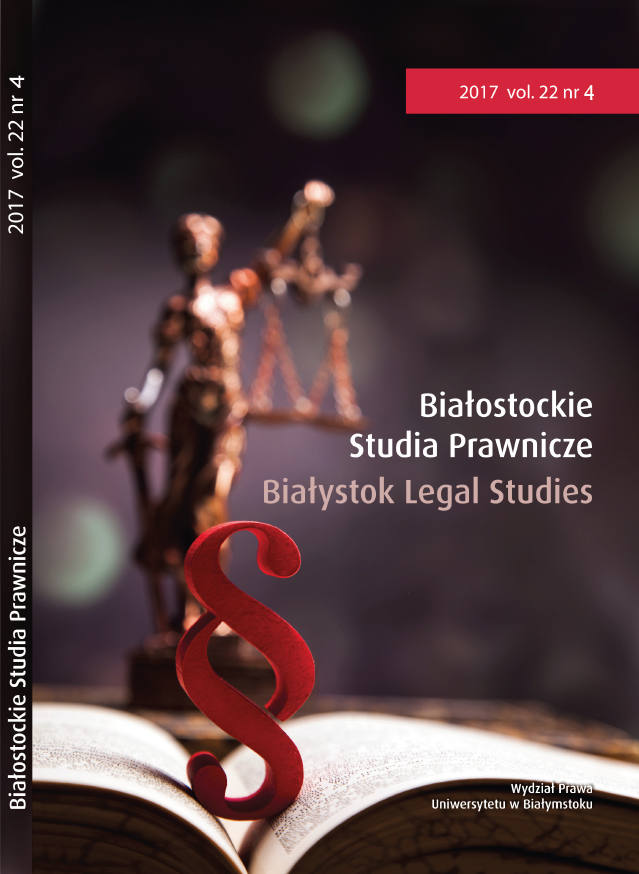Kierunek zmian przepisów o formie testamentu w dobie nowych technologii na przykładzie Szwajcarii
Abstrakt
The problems of inheritance law change with the needs of society. In the era of new technologies there is a temptation to use them to achieve goals set by law. One of the areas of inheritance law that can be adapted to changing reality resulting from the possibilities created by the benevolence of technology, is the area of the form of the will. The testament, as a formal legal act, must be drawn up in a form prescribed by law. Should this form be based on new technology solutions is a dilemma, which is analyzed by the author on the example of proposals for changes in Swiss law.Bibliografia
Basedow J., Codification of Private Law in the European Union: the Making of a Hybrid, „European Review of Private Law” 2001, nr 1.
Borysiak W., Funkcjonowanie w praktyce testamentu sporządzanego w formie ustnej (art. 952 kc.), Warszawa 2014.
Breitschmid P., Testament und Erbvertrag – Formprobleme: Die Einsatzmöglichkeiten für die Nachlassplanung im Lichte neuerer Rechtsentwicklungen, (w:) P. Breitschmid (red.), Testament und Erbvertrag, Bern/Stuttgart 1991.
Breitschmid P., Revision der Formvorschrift en des Testaments – Bemerkungen zur Umsetzung der „Initiative Guinand”, „Zeitschrift des Bernischen Juristenvereins” 1995, nr 3.
Cserne P., Draft ing Civil Codes in Central and Eastern Europe. A Case Study on the Role of Legal Scholarship in Law-making, „Pro Publico Bono Online” 2011.
Darwall S., The Value of Autonomy and Autonomy of the Will, „Ethics” 2006, nr 1.
Garlicki L. (red.), Konstytucja Szwajcarii, Warszawa 2000.
Gee K.B., Beyond Castro’s Tablet Will: Exploring Electronic Will Cases Around the World and Re-visiting Ohio’s Harmless Error Statute, „Probate Journal of Ohio” 2016, t. 26, nr 4.
Łukaszyk J., Kierunki zmian szwajcarskiego prawa spadkowego, „Studia Prawnicze PAN” 2010, nr 1.
Moreteau O., A Summary Reflection on the Future of Civil Codes in Europe, (w:) P. Apathy et al. (red.), Festschrift fur Helmut Koziol zum 70. Geburtstag, Wien 2010.
Muscheler K., Das eigenhändige Testament – gestern, heute und morgen, „Successio – Zeitchrift für Erbrecht” 2014, nr 1.
Osajda K., Wpływ rozwoju techniki na uregulowanie formy testamentu – rozważania de lege ferenda, „Rejent” 2010, nr 5.
Pabin A., Testament jako akt sformalizowany – uwagi w sprawie przyszłego kształtu regulacji dotyczących formy rozrządzeń testamentowych, „Studia Prawnicze” 2016, nr 1.
Pazdan M., Wybrane projektowane zmiany w prawie spadkowym, (w:) Nowy kodeks cywilny odpowiedzią na wyzwania współczesności – konferencja naukowa (Warszawa, 10 kwietnia 2015 r.), Warszawa 2015.
Pollaroli M.A., EU Regulation no. 650/2012 and Access to New Forms of Intergenerational Transfer of Wealth, „Ricerche Giuridiche” 2013, nr 1 (Supplemento).
Radwański Z. (red.), Zielona księga. Optymalna wizja Kodeksu cywilnego w Rzeczypospolitej Polskiej, Warszawa 2006.
Rothel A., Verhandlungen des 68. Deutschen Juristentages. Gutachten/Teil A: Ist unser Erbrecht noch zeitgemäß?, München 2010.
Ryffel G., Repetitorium des schweizerischen Erbrechts, Zürich 2004.
Sanchez E.V., Are We Ready for Electronic Wills, „Notes on Business Education” 2006, nr 2.
Sandoz S., Switzerland, (w:) W. Pintens (red.), International Encyclopaedia For Family and Succession Law, Alphen aan den Rijn 2006, t. 31.
Tuor P., Schnyder B., Das schweizerische Zivilgesetzbuch, Zürich 1986.
Wilke F.M., Das internationale Erbrecht nach der neuen EU-Erbrechtsverordnung, „Recht der Internationalen Wirtschaft ” 2012, nr 9.
Wolf S., Genna G.S., Erbrecht, Basel 2012.
Zakrzewski P., Kierunki zmian polskiego prawa spadkowego, „Przegląd Prawno-Ekonomiczny” 2008, nr 2.
Załucki M., Współczesne tendencje rozwoju ustawodawstwa testamentowego, „Roczniki Nauk Prawnych” 2012, nr 2.
Załucki M., Uniform European Inheritance Law. Myth, Dream or Reality of the Future, Kraków 2015.
Załucki M. (red.), Unijne rozporządzenie spadkowe Nr 650/2012. Komentarz, Warszawa 2015.
Zimmermann R., Testamentsformen: «Willkür» oder Ausdruck einer Rechtskultur?, „Rabels Zeitschrift für ausländisches und internationales Privatrecht” 2012, nr 76.



